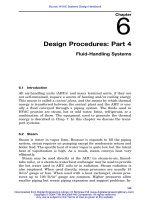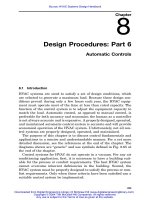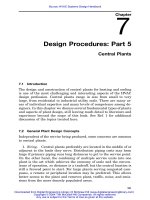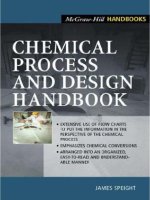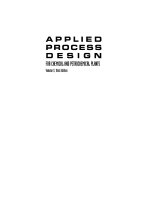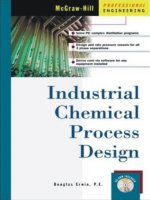chemical process & design handbook
Bạn đang xem bản rút gọn của tài liệu. Xem và tải ngay bản đầy đủ của tài liệu tại đây (2.35 MB, 559 trang )
MCGRAW-HILL
New York Chicago San Francisco Lisbon London Madrid
Mexico City Milan New Delhi San Juan Seoul
Singapore Sydney Toronto
CHEMICAL AND
PROCESS DESIGN
HANDBOOK
James G. Speight
FM_Speight_HB1 11/8/01 3:43 PM Page iii
Library of Congress Cataloging-in-Publication Data
Speight, J. G.
Chemical and process design handbook / James Speight.
p. cm.
Includes index.
ISBN 0-07-137433-7 (acid-free paper)
1. Chemical processes. I. Title.
TP155.7 .S63 2002
660′.2812—dc21 2001052555
Copyright © 2002 by The McGraw-Hill Companies, Inc. All rights reserved.
Printed in the United States of America. Except as permitted under the United
States Copyright Act of 1976, no part of this publication may be reproduced or
distributed in any form or by any means, or stored in a data base or retrieval sys-
tem, without the prior written permission of the publisher.
1234567890 DOC/DOC 0987654321
ISBN 0-07-137433-7
The sponsoring editor for this book was Kenneth P. McCombs, the editing super-
visor was David E. Fogarty, and the production supervisor was Pamela A.
Pelton. It was set in the HB1A design in Times Roman by Kim Sheran, Deirdre
Sheean, and Vicki Hunt of McGraw-Hill Professional’s Hightstown, New Jersey,
composition unit.
Printed and bound by R. R. Donnelley & Sons Company.
This book was printed on recycled, acid-free paper containing
a minimum of 50% recycled, de-inked fiber.
McGraw-Hill books are available at special quantity discounts to use as premiums
and sales promotions, or for use in corporate training programs. For more
information, please write to the Director of Special Sales, Professional Publishing,
McGraw-Hill, Two Penn Plaza, New York, NY 10121-2298. Or contact your
local bookstore.
McGraw-Hill
Information contained in this work has been obtained by The McGraw-Hill
Companies, Inc. (“McGraw-Hill”) from sources believed to be reliable. However,
neither McGraw-Hill nor its authors guarantee the accuracy or completeness of any
information published herein, and neither McGraw-Hill nor its authors shall be
responsible for any errors, omissions, or damages arising out of use of this informa-
tion. This work is published with the understanding that McGraw-Hill and its authors
are supplying information but are not attempting to render engineering or other pro-
fessional services. If such services are required, the assistance of an appropriate
professional should be sought.
FM_Speight_HB1 11/8/01 3:44 PM Page iv
ABOUT THE AUTHOR
James G. Speight is the author/editor/compiler of more than 20 books and bibliographies
related to fossil fuel processing and environmental issues. As a result of his work, Dr. Speight
was awarded the Diploma of Honor, National Petroleum Engineering Society, for Out-
standing Contributions in the Petroleum Industry in 1995 and the Gold Medal of Russian
Academy of Natural Sciences for Outstanding Work. He was also awarded the Degree of
Doctor of Science from the Russian Petroleum Research Institute in St. Petersburg.
Index_Speight_HB1 6x9 11/8/01 3:43 PM Page I.11
CONTENTS
Preface xiii
Part 1 Reaction Types
Alkylation / 1.3
Amination / 1.6
Condensation and Addition / 1.12
Dehydration / 1.13
Dehydrogenation / 1.14
Esterfication / 1.16
Ethynylation / 1.17
Fermentation / 1.18
Friedel-Crafts Reactions / 1.19
Halogenation / 1.21
Hydration and Hydrolysis / 1.24
Hydroformylation / 1.27
Hydrogenation / 1.29
Nitration / 1.32
Oxidation / 1.36
Oxo Reaction / 1.40
Polymerization / 1.41
Sulfonation / 1.43
Vinylation / 1.46
Part 2 Manufacture of Chemicals
Acetaldehyde / 2.3
Acetal Resins / 2.7
Acetaminophen / 2.10
Acetic Acid / 2.11
Acetic Anhydride / 2.14
Acetone / 2.16
Acetone Cyanohydrin / 2.18
Acetophenetidine / 2.19
Acetylene / 2.20
Acrolein / 2.23
Acrylic Acid / 2.25
Acrylic Resins / 2.27
Acrylonitrile / 2.28
Adipic Acid / 2.30
Adiponitrile / 2.32
Alcohols, Linear Ethoxylated / 2.33
Alkanolamines / 2.34
Alkyd Resins / 2.36
v
FM_Speight_HB1 11/8/01 3:44 PM Page v
Alkylbenzenes, Linear / 2.38
Allyl Alcohol / 2.39
Alumina / 2.42
Aluminum / 2.44
Aluminum Chloride / 2.45
Aluminum Sulfate / 2.46
Amitriptyline / 2.47
Ammonia / 2.49
Ammonium Chloride / 2.52
Ammonium Nitrate / 2.53
Ammonium Phosphate / 2.56
Ammonium Picrate / 2.58
Ammonium Sulfate / 2.59
Aniline / 2.60
Anisaldehyde / 2.61
Antibiotics / 2.62
Antihistamines / 2.63
Argon / 2.65
Aspirin / 2.66
Barbital / 2.67
Barbiturates / 2.68
Barium Carbonate / 2.69
Barium Salts / 2.70
Barium Sulfate / 2.71
Barium Sulfide / 2.72
Bauxite / 2.73
Benzaldehyde / 2.74
Benzene / 2.75
Benzine / 2.80
Benzodiazepines / 2.81
Benzoic Acid / 2.83
Benzyl Acetate / 2.84
Benzyl Alcohol / 2.85
Bisphenol A / 2.86
Borax / 2.87
Boron Compounds / 2.88
Bromal / 2.89
Bromine / 2.90
Bromoacetaldehyde / 2.92
BTX Aromatics / 2.93
Butadiene / 2.95
Butane / 2.98
Butanediol / 2.99
Iso-butane / 2.102
Butene-1 / 2.103
Butenediol / 2.104
Iso-butene / 2.106
n-Butene / 2.107
Butyl Acrylate / 2.108
Iso-butyl Alcohol / 2.109
n-Butyl Alcohol / 2.110
t-Butyl Alcohol / 2.111
Butyl Vinyl Ether / 2.112
Butynediol / 2.113
Iso-butyraldehyde / 2.115
n-Butryaldehyde / 2.116
Butyrolactone / 2.118
Caffeine, Theobromine, and Theophylline / 2.119
vi
CONTENTS
FM_Speight_HB1 11/8/01 3:44 PM Page vi
Calcite / 2.120
Calcium Acetate / 2.121
Calcium Arsenate / 2.122
Calcium Bromide / 2.123
Calcium Carbonate / 2.124
Calcium Chloride / 2.126
Calcium Fluoride / 2.127
Calcium Hypochlorite / 2.128
Calcium Iodide / 2.129
Calcium Lactate / 2.130
Calcium Oxide / 2.131
Calcium Phosphate / 2.134
Calcium Soaps / 2.135
Calcium Sulfate / 2.136
Calcium Sulfide / 2.137
Caprolactam / 2.138
Carbon / 2.141
Carbon Black / 2.146
Carbon Dioxide / 2.147
Carbon Monoxide / 2.150
Carbon Tetrachloride / 2.151
Cellulose / 2.152
Cellulose Acetate / 2.153
Cellulose Nitrate / 2.154
Cement / 2.156
Cephalosporins / 2.158
Chloral / 2.159
Chlorinated Solvents / 2.160
Chlorine / 2.161
Chlorine Dioxide / 2.164
Chloroacetaldehyde / 2.165
Chlorofluorocarbons / 2.166
Chloroform / 2.167
Chloroprene / 2.168
Chromic Oxide / 2.169
Cimetidine / 2.170
Cinnamic Aldehyde / 2.171
Citric Acid / 2.172
Coal Chemicals / 2.174
Cocaine / 2.179
Codeine / 2.180
Coke / 2.181
Copper Sulfate / 2.182
Cumene / 2.183
Cyclohexane / 2.185
Cyclohexanol / 2.186
Cyclohexanone / 2.187
Darvon / 2.188
Detergents / 2.190
Diazepam / 2.193
Diazodinitrophenol / 2.194
Diethylene Glycol / 2.195
Diethyl Sulfate / 2.196
Dihydrooxyacetone / 2.197
Dimethyl Sulfate / 2.198
Dimethyl Terephthalate / 2.199
2,4- and 2,6-Dinitrotoluene / 2.200
Diphenyl Ether / 2.201
CONTENTS vii
FM_Speight_HB1 11/8/01 3:44 PM Page vii
Dyazide / 2.202
Dyes / 2.203
Dynamite / 2.205
Epoxy Resins / 2.206
Erythromycin / 2.207
Ethane / 2.208
Ethanolamines / 2.209
Ether / 2.211
Ethyl Acetate / 2.212
Ethyl Alcohol / 2.213
Ethylbenzene / 2.218
Ethylene / 2.220
Ethylene Dichloride / 2.225
Ethylene Glycol / 2.227
Ethylene Oxide / 2.229
Ethylhexanol / 2.231
Ethyl Vinyl Ether / 2.232
Explosive D / 2.233
Explosives / 2.234
Ferric Oxide / 2.235
Ferrocyanide Blue / 2.236
Fertilixers / 2.237
Fluorine / 2.240
Fluorocarbons / 2.242
Formaldehyde / 2.244
Furosemide / 2.246
Gasoline / 2.247
Glass / 2.249
Glutamic Acid / 2.250
Glycerol / 2.251
Graphite / 2.254
Gypsum / 2.255
Helium / 2.256
Herbicides / 2.257
Hexamethylenediamine / 2.258
Hexamethylenetetramine / 2.259
Hexamine / 2.260
Hexanes / 2.261
Hexylresorcinol / 2.262
Hydrochloric Acid / 2.263
Hydrofluoric Acid / 2.265
Hydrogen / 2.266
Hydrogen Cyanide / 2.269
Hydrogen Peroxide / 2.270
Ibuprofen / 2.271
Insecticides / 2.272
Insulin / 2.274
Iodine / 2.276
Isoniazid / 2.279
Isoprene / 2.280
Iso-propyl Alcohol / 2.281
Isoquinoline / 2.282
Kerosene / 2.283
Kevlar / 2.284
Krypton / 2.285
Lactic Acid / 2.286
Lead Azide / 2.287
Lead Carbonate / 2.288
viii
CONTENTS
FM_Speight_HB1 11/8/01 3:44 PM Page viii
Lead Chromate / 2.290
Lead Styphnate / 2.291
Lignon / 2.292
Lignosulfonates / 2.293
Lime / 2.294
Linear Alpha Olefins / 2.295
Liquefied Petroleum Gas / 2.296
Lithium Salts / 2.297
Lithopone / 2.298
Magnesium / 2.300
Magnesium Carbonate / 2.303
Magnesium Chloride / 2.304
Magnesium Compounds / 2.305
Magnesium Hydroxide / 2.307
Magnesium Oxide / 2.308
Magnesium Peroxide / 2.309
Magnesium Silicate / 2.310
Magnesium Sulfate / 2.311
Malathion / 2.312
Maleic Acid / 2.313
Maleic Anhydride / 2.314
Melamine Resins (Malamine-Formadehyde Polymers) / 2.316
Mercury Fulminate / 2.317
Metaldehyde / 2.318
Methane / 2.319
Methyl Acetate / 2.321
Methyl Alcohol / 2.322
Methylamines / 2.324
Methyl Chloride / 2.325
Methylene Chloride / 2.326
Methylene Diphenyl Diisocyanate / 2.327
Methyl Ethyl Ketone / 2.328
Methyl Mathacrylate / 2.330
Methyl Tertiary Butyl Ether / 2.331
Methyl Vinyl Ether / 2.333
Molybdenum Compounds / 2.334
Monosodium Glutamate / 2.335
Morphine / 2.337
Naphtha / 2.339
Napthalene / 2.344
Natural Gas / 2.346
Natural Gas (Substitute) / 2.349
Neon / 2.351
Nicotine / 2.352
Nicotinic Acid and Nicotinamide / 2.353
Nitric Acid / 2.354
Nitrobenzene / 2.356
Nitrocellulose / 2.357
Nitrogen / 2.358
Nitroglycerin / 2.361
Nitrous Oxide / 2.363
Nonene / 2.364
Novocaine / 2.365
Nylon / 2.366
Ocher / 2.367
Iso-octane / 2.368
Oxygen / 2.369
Paints / 2.371
CONTENTS ix
FM_Speight_HB1 11/8/01 3:44 PM Page ix
n-Paraffins / 2.373
Paraldehyde / 2.374
Penicillin / 2.375
Pentaerythritol / 2.376
Peracetic Acid / 2.379
Perchloroethylene / 2.380
PETN / 2.381
Petrochemicals / 2.382
Phenobarbital / 2.388
Phenol / 2.389
Phenolic Resins / 2.392
Phenolphthalein / 2.394
Phenothiazines / 2.395
Phenylethyl Alcohol / 2.396
Phosgene / 2.397
Phosphoric Acid / 2.398
Phosphorus / 2.401
Phthalic Acid / 2.403
Phthalic Anhydride / 2.404
Phthalocyanine Blue / 2.405
Phthalocyanine Green / 2.406
Picric Acid / 2.407
Piperazine Citrate / 2.408
Polyacetaldehyde / 2.409
Polyamides / 2.410
Polycarbonates / 2.412
Polychlorinated Biphenyls / 2.413
Polyesters / 2.414
Polyesters (Unsaturated) / 2.416
Polyhydric Alcohols / 2.417
Polyimides / 2.418
Polysulfones / 2.419
Polyurethane Foams / 2.420
Potassium Chlorate / 2.421
Potassium Compounds / 2.422
Potassium Hydroxide / 2.423
Potassium Nitrate / 2.424
Potassium Perchlorate / 2.425
Producer Gas / 2.426
Propane / 2.427
Propanol Hydrochloride / 2.428
Propargyl Alcohol / 2.429
Propene / 2.431
Iso-propyl Alcohol / 2.433
Propylene Glycol / 2.434
Propylene Oxide / 2.435
Pulp and Paper Chemicals / 2.438
Pyridine / 2.440
Pyrophosphates / 2.441
Quinoline / 2.442
Iso-quinoline / 2.443
Rare Gases / 2.444
RDX / 2.446
Red Lead / 2.447
Reserpine / 2.448
Rotenone / 2.449
x
CONTENTS
FM_Speight_HB1 11/8/01 3:44 PM Page x
Rubber (Natural) / 2.450
Rubber (Synthetic) / 2.451
Salicylic Acid / 2.453
Silica Gel / 2.455
Silver Sulfate / 2.456
Soap / 2.457
Sodium / 2.459
Sodium Bicarbonate / 2.460
Sodium Bisulfite / 2.461
Sodium Carbonate / 2.462
Sodium Chlorate / 2.465
Sodium Chloride / 2.467
Sodium Chlorite / 2.469
Sodium Dichromate / 2.470
Sodium Hydroxide / 2.472
Sodium Hypochlorite / 2.475
Sodium Metabisulfite / 2.476
Sodium Nitrate / 2.477
Sodium Perchlorate / 2.478
Sodium Phosphate / 2.479
Sodium Pyrosulfite / 2.480
Sodium Silicate / 2.481
Sodium Sulfate / 2.482
Sodium Sulfite / 2.483
Sodium Triphosphate / 2.484
Steroids / 2.485
Streptomycin / 2.489
Styrene / 2.490
Sulfonamides / 2.493
Sulfur / 2.494
Sulfur Dioxide / 2.496
Sulfuric Acid / 2.497
Sulfurous Acid / 2.500
Sulfur Trioxide / 2.501
Superphosphates / 2.502
Surfactants / 2.503
Surfactants (Amphoteric) / 2.504
Surfactants (Anionic) / 2.505
Surfactants (Cationic) / 2.506
Surfactants (Nonionic) / 2.507
Synthesis Gas / 2.508
Talc / 2.511
Tall Oil / 2.512
Terephthalic Acid / 2.513
Tetrachloroethylene / 2.515
Tetracyclines / 2.516
Tetrahydofuran / 2.517
Tetrazine / 2.518
Tetryl / 2.519
Titanium Dioxide / 2.520
Toluene / 2.523
Toluene Diisocyanate / 2.528
1,1,1-Trichloroethane / 2.529
Trichloroethylene / 2.530
Triethylene Glycol / 2.531
Trinitrotoluene / 2.532
Turpentine / 2.533
CONTENTS xi
FM_Speight_HB1 11/8/01 3:44 PM Page xi
Urea / 2.535
Urea Resins / 2.538
Valium / 2.539
Vinyl Acetate / 2.540
Vinyl Chloride / 2.542
Vinyl Esters / 2.544
Vinyl Ethers / 2.545
Vinyl Fluoride / 2.546
Vinylidene Chloride / 2.547
Vinylidene Fluoride / 2.548
Water Gas / 2.549
Wax / 2.550
Wood Chemicals / 2.552
Xenon / 2.556
Xylenes / 2.557
Zinc Chromate / 2.561
Zinc Oxide / 2.562
Zinc Sulfate / 2.564
Zinc Sulfide / 2.565
Index I.1
xii CONTENTS
FM_Speight_HB1 11/8/01 3:44 PM Page xii
PREFACE
Chemicals are part of our everyday lives. The hundreds of chemicals that
are manufactured by industrial processes influence what we do and how
we do it. This book offers descriptions and process details of the most pop-
ular of those chemicals. The manufacture of chemicals involves many
facets of chemistry and engineering which are exhaustively treated in a
whole series of encyclopedic works, but it is not always simple to rapidly
grasp present status of knowledge from these sources. Thus, there is a
growing demand for a text that contains concise descriptions of the most
important chemical conversions and processes of industrial operations.
This text will, therefore, emphasize the broad principles of systems of
chemicals manufacture rather than intimate and encyclopedic details that
are often difficult to understand. As such, the book will allow the reader to
appreciate the chemistry and engineering aspects of important precursors
and intermediates as well as to follow the development of manufacturing
processes to current state-of-the-art processing.
This book emphasizes chemical conversions, which may be defined as
chemical reactions applied to industrial processing. The basic chemistry
will be set forth along with easy-to-understand descriptions, since the
nature of the chemical reaction will be emphasized in order to assist in
the understanding of reactor type and design. An outline is presented
of the production of a range of chemicals from starting materials into
useful products. These chemical products are used both as consumer
goods and as intermediates for further chemical and physical modifica-
tion to yield consumer products.
Since the basis of chemical-conversion classification is a chemical one,
emphasis is placed on the important industrial chemical reactions and
chemical processes in Part 1 of this book. These chapters focus on the var-
ious chemical reactions and the type of equipment that might be used in
such processes. The contents of this part are in alphabetical order by reac-
tion name.
Part 2 presents the reactions and processes by which individual chemicals,
or chemical types, are manufactured and is subdivided by alphabetical listing
xiii
FM_Speight_HB1 11/8/01 3:44 PM Page xiii
of the various chemicals. Each item shows the chemical reaction by which
that particular chemical can be manufactured. Equations are kept simple
so that they can be understood by people in the many scientific and engineer-
ing disciplines involved in the chemical manufacturing industry. Indeed, it is
hoped that the chemistry is sufficiently simple that nontechnical readers can
understand the equations.
The design of equipment can often be simplified by the generalizations
arising from a like chemical-conversion arrangement rather than by con-
sidering each reaction as unique.
Extensive use of flowcharts is made as a means of illustrating the various
processes and to show the main reactors and the paths of the feedstocks
and products. However, no effort is made to include all of the valves and
ancillary equipment that might appear in a true industrial setting. Thus, the
flowcharts used here have been reduced to maximum simplicity and are
designed to show principles rather than details.
Although all chemical manufacturers should be familiar with the current
selling prices of the principal chemicals with which they are concerned,
providing price information is not a purpose of this book. Prices per unit
weight or volume are subject to immediate changes and can be very mis-
leading. For such information, the reader is urged to consult the many
sources that deal with the prices of chemical raw materials and products.
In the preparation of this work, the following sources have been used to
provide valuable information:
AIChE Journal (AIChE J.)
Canadian Journal of Chemistry
Canadian Journal of Chemical Engineering
Chemical and Engineering News (Chem. Eng. News)
ChemTech
Chemical Week (Chem. Week)
Chemical Engineering Progress (Chem. Eng. Prog.)
Chemical Processing Handbook, J. J. McKetta (ed.), Marcel Dekker,
New York.
Encyclopedia of Chemical Technology, 4th ed., It. E. Kirk, and D. F.
Othmer(eds.) Wiley-Interscience, New York
Chemical Engineers' Handbook, 7th ed., R. H. Perry and D. W. Green
(eds.), McGraw-Hill, New York.
Chemical Processing
xiv PREFACE
FM_Speight_HB1 11/8/01 3:44 PM Page xiv
Handbook of Chemistry and Physics, Chemical Rubber Co.
Hydrocarbon Processing
Industrial and Engineering Chemistry (Ind. Eng. Chem.)
Industrial and Engineering Chemistry Fundamentals (Ind. Eng. Chem.
Fundamentals)
Industrial and Engineering Chemistry Process Design and Development
(Ind. Eng. Chem. Process Des. Dev.)
Industrial and Engineering Chemistry Product Research and Devel-
opment (Ind. Eng. Chem. Prod. Res. Dev.)
International Chemical Engineering
Journal of Chemical and Engineering Data (J. Chem. Eng. Data)
Journal of the Chemical Society
Journal of the American Chemical Society
Lange's Handbook of Chemistry, 12th ed., J. A. Dean (ed.). McGraw-Hill,
New York
Oil & Gas Journal
McGraw-Hill Encyclopedia of Science and Technology, 5th ed., McGraw-
Hill, New York
Riegel's Industrial Chemistry, 7th ed., J. A. Kent (ed.), Reinhold,
New York
Finally, I am indebted to my colleagues in many different countries who
have continued to engage me in lively discussions and who have offered
many thought-provoking comments about industrial processes. Such con-
tacts were of great assistance in the writing of this book and have been
helpful in formulating its contents.
James G. Speight
PREFACE xv
FM_Speight_HB1 11/8/01 3:44 PM Page xv
REACTION TYPES
Part 1
Speight_Part 1_A 11/7/01 3:04 PM Page 1.1
ALKYLATION
Alkylation is usually used to increase performance of a product and
involves the conversion of, for example, an amine to its alkylated homologs
as in the reaction of aniline with methyl alcohol in the presence of sulfuric
acid catalyst:
C
6
H
5
NH
2
+ 2CH
3
OH → C
6
H
5
N(CH
3
)
2
+ 2H
2
O
Thus, aniline, with a considerable excess of methyl alcohol and a catalytic
amount of sulfuric acid, is heated in an autoclave at about 200
o
C for 5 or
6 hours at a high reaction pressure of 540 psi (3.7 MPa). Vacuum distilla-
tion is used for purification.
In the alkylation of aniline to diethylaniline by heating aniline and ethyl
alcohol, sulfuric acid cannot be used because it will form ether; conse-
quently, hydrochloric acid is employed, but these conditions are so corrosive
that the steel used to resist the pressure must be fitted with replaceable enam-
eled liners.
Alkylation reactions employing alkyl halides are carried out in an acidic
medium. For example, hydrobromic acid is formed when methyl bromide
is used in the alkylation leading, and for such reactions an autoclave with
a replaceable enameled liner and a lead-coated cover is suitable.
In the petroleum refining industry, alkylation is the union of an olefin
with an aromatic or paraffinic hydrocarbon:
CH
2
=CH
2
+ (CH
3
)
3
CH → (CH
3
)
3
CCH
2
CH
3
Alkylation processes are exothermic and are fundamentally similar to
refining industry polymerization processes but they differ in that only part
of the charging stock need be unsaturated. As a result, the alkylate product
contains no olefins and has a higher octane rating. These methods are
based on the reactivity of the tertiary carbon of the iso-butane with olefins,
such as propylene, butylenes, and amylenes. The product alkylate is a mix-
ture of saturated, stable isoparaffins distilling in the gasoline range, which
becomes a most desirable component of many high-octane gasolines.
1.3
Speight_Part 1_A 11/7/01 3:04 PM Page 1.3
Contactor
Feedstock
Separator
Acid, to
regenerator
Hydrogen fluoride
Stripper
Hydrogen
fluoride recycle
Deisobutanizer
Debutanizer
To depropanizer
Heavy alkylate
Light alkylate
Butane
FIGURE 1 Alkylation using hydrogen fluoride.
Alkylation is accomplished by using either of two catalysts: (1) hydro-
gen fluoride and (2) sulfuric acid. In the alkylation process using liquid
hydrogen fluoride (Fig. 1), the acid can be used repeatedly, and there is
virtually no acid-disposal problem. The acid/hydrocarbon ratio in the con-
tactor is 2:1 and temperature ranges from 15 to 35
o
C can be maintained
since no refrigeration is necessary. The anhydrous hydrofluoric acid is
regenerated by distillation with sufficient pressure to maintain the reac-
tants in the liquid phase.
In many cases, steel is suitable for the construction of alkylating equip-
ment, even in the presence of the strong acid catalysts, as their corrosive
effect is greatly lessened by the formation of esters as catalytic intermedi-
ate products.
In the petroleum industry, the sulfuric acid and hydrogen fluoride
employed as alkylation catalysts must be substantially anhydrous to be
effective, and steel equipment is satisfactory. Where conditions are not
anhydrous, lead-lined, monel-lined, or enamel-lined equipment is satisfac-
tory. In a few cases, copper or tinned copper is still used, for example, in
the manufacture of pharmaceutical and photographic products to lessen
contamination with metals.
Distillation is usually the most convenient procedure for product recov-
ery, even in those instances in which the boiling points are rather close
together. Frequently such a distillation will furnish a finished material of
1.4 REACTION TYPES
Speight_Part 1_A 11/7/01 3:04 PM Page 1.4
quality sufficient to meet the demands of the market. If not, other means of
purification may be necessary, such as crystallization or separation by
means of solvents. The choice of a proper solvent will, in many instances,
lead to the crystallization of the alkylated product and to its convenient
recovery.
The converse reactions dealkylation and hydrodealkylation are prac-
ticed extensively to convert available feedstocks into other more desirable
(marketable), products. Two such processes are: (1) the conversion of
toluene or xylene, or the higher-molecular-weight alkyl aromatic com-
pounds, to benzene in the presence of hydrogen and a suitable presence of
a dealkylation catalyst and (2) the conversion of toluene in the presence of
hydrogen and a fixed bed catalyst to benzene plus mixed xylenes.
ALKYLATION 1.5
Speight_Part 1_A 11/7/01 3:04 PM Page 1.5
AMINATION
Amination is the process of introducing the amino group (–NH
2
) into an
organic compound as, for example, the production of aniline (C
6
H
5
NH
2
)
by the reduction of nitrobenzene (C
6
H
5
NO
2
) in the liquid phase (Fig. 1)
or in the vapor phase in a fluidized bed reactor (Fig. 2). For many
decades, the only method of putting an amino group on an aryl nucleus
involved adding a nitro (–NO
2
) group, then reduction to the amino
(–NH
2
) group.
Without high-pressure vessels and catalysts, reduction had to be done
by reagents that would function under atmospheric pressure. The common
reducing agents available under these restrictions are:
1. Iron and acid
2. Zinc and alkali
3. Sodium sulfide or polysulfide
4. Sodium hydrosulfite
5. Electrolytic hydrogen
6. Metal hydrides
Now liquid- and gas-phase hydrogenations can be performed on a vari-
ety of materials.
RNO
2
+ 3H
2
→ RNH
2
+ 2H
2
O
Where metals are used to produce the reducing hydrogen, several difficult
processing problems are created. The expense is so great that it is necessary
to find some use for the reacted material. Spent iron can sometimes be used
for pigment preparations or to absorb hydrogen sulfide. Stirring a vessel con-
taining much metal is quite difficult.
On a small scale, cracking ammonia can produce hydrogen for reduc-
tion. Transport and storage of hydrogen as ammonia is compact, and the
cracking procedure involves only a hot pipe packed with catalyst and
1.6
Speight_Part 1_A 11/7/01 3:04 PM Page 1.6
AMINATION 1.7
Nitrobenzene
Iron filings
Hydrochloric
acid
Reducer
Sludge
Separator
Water, to
treatment
Purification still
Crude aniline
Pure aniline
FIGURE 1 Aniline production by the reduction of nitrobenzene.
Reactor
Nitrobenzene
Hydrogen
Hydrogen recycle
Water
Crude aniline still
Purification still
Aniline
Water, to
treatment
Water
plus
reject
Separator
FIGURE 2 Vapor phase reduction of nitrobenzene to aniline.
Speight_Part 1_A 11/7/01 3:04 PM Page 1.7
immersed in a molten salt bath. The nitrogen that accompanies the gener-
ated hydrogen is inert.
Amination is also achieved by the use of ammonia (NH
3
), in a process
referred to as ammonolysis. An example is the production of aniline
(C
6
H
5
NH
2
) from chlorobenzene (C
6
H
5
Cl) with ammonia (NH
3
). The reac-
tion proceeds only under high pressure.
The replacement of a nuclear substituent such as hydroxyl (–OH),
chloro, (–Cl), or sulfonic acid (–SO
3
H) with amino (–NH
2
) by the use of
ammonia (ammonolysis) has been practiced for some time with feed-
stocks that have reaction-inducing groups present thereby making
replacement easier. For example, 1,4-dichloro-2-nitrobenzene can be
changed readily to 4-chloro-2-nitroaniline by treatment with aqueous
ammonia. Other molecules offer more processing difficulty, and pressure
vessels are required for the production of aniline from chlorobenzene or
from phenol (Fig. 3).
C
6
H
5
OH + NH
3
→ C
6
H
5
NH
2
+ H
2
O
Ammonia is a comparatively low cost reagent, and the process can
be balanced to produce the desired amine. The other routes to amines
1.8 REACTION TYPES
Phenol
Ammonia
Catalytic
reactor
Ammonia recovery column
Dehydrating column
Purification column
Bottoms removal column
Ammonia recycle Water Aniline Azeotrope
Azeotrope recycle
Diphenylamine
FIGURE 3 Aniline and diphenylamine production from phenol.
Speight_Part 1_A 11/7/01 3:04 PM Page 1.8
through reduction use expensive reagents (iron, Fe, zinc, Zn, or hydrogen,
H
2
, gas) that make ammonolysis costs quite attractive. Substituted amines
can be produced by using substituted ammonia (amines) in place of sim-
ple ammonia. The equipment is an agitated iron pressure vessel; stainless
steel is also used for vessel construction.
Amination by reduction is usually carried out in cast-iron vessels (1600
gallons capacity, or higher) and alkali reductions in carbon steel vessels of
desired sizes. The vessel is usually equipped with a nozzle at the base so
that the iron oxide sludge or entire charge may be run out upon completion
of the reaction.
In some reducers, a vertical shaft carries a set of cast-iron stirrers to keep
the iron particles in suspension in the lower part of the vessel and to main-
tain all the components of the reaction in intimate contact. In addition, the
stirrer assists in the diffusion of the amino compound away from the sur-
face of the metal and thereby makes possible a more extensive contact
between nitro body and catalytic surface.
Thus, amination, or reaction with ammonia, is used to form both aliphatic
and aromatic amines. Reduction of nitro compounds is the traditional process
for producing amines, but ammonia or substituted ammonias (amines) react
directly to form amines. The production of aniline by amination now exceeds
that produced by reduction (of nitrobenzene).
Oxygen-function compounds also may be subjected to ammonolysis,
for example:
1. Methanol plus aluminum phosphate catalyst yields monomethylamine
(CH
3
NH
2
), dimethylamine [(CH
3
)2NH], and trimethylamine
[(CH
3
)3N]
2. 2-naphthol plus sodium ammonium sulfite (NaNH
3
SO
3
) catalyst
(Bucherer reaction) yields 2-naphthylamine
3. Ethylene oxide yields monoethanolamine (HOCH
2
CH
2
NH
2
),
diethanolamine [(HOCH
2
CH
2
)
2
NH)], and triethanolamine
[(HOCH
2
CH
2
)
3
N)]
4. Glucose plus nickel catalyst yields glucamine
5. Cyclohexanone plus nickel catalyst yields cyclohexylamine
Methylamines are produced by reacting gaseous methanol with a cata-
lyst at 350 to 400
o
C and 290 psi (2.0 MPa), then distilling the reaction mix-
ture. Any ratio of mono-, di-, or trimethylamines is possible by recycling
the unwanted products.
AMINATION 1.9
Speight_Part 1_A 11/7/01 3:04 PM Page 1.9
An equilibrium mixture of the three ethanolamines is produced when eth-
ylene oxide is bubbled through 28% aqueous ammonia at 30 to 40
o
C. By
recirculating the products of the reaction, altering the temperatures, pressures,
and the ratio of ammonia to ethylene oxide, but always having an excess of
ammonia, it is possible to make the desired amine predominate. Diluent gas
also alters the product ratio.
CH
2
CH
2
O +NH
3
→ HOCH
2
CH
2
NH
2
+ H
2
O
monoethanolamine
2CH
2
CH
2
O + NH
3
→ (HOCH
2
CH
2
)
2
NH + 2H
2
O
diethanolamine
3CH
2
CH
2
O + NH
3
→ (HOCH
2
CH
2
)
3
N + 3H
2
O
triethanolamine
After the strongly exothermic reaction, the reaction products are recov-
ered and separated by flashing off and recycling the ammonia, and then
fractionating the amine products.
Monomethylamine is used in explosives, insecticides, and surfactants.
Dimethylamine is used for the manufacture of dimethylformamide and
acetamide, pesticides, and water treatment. Trimethylamine is used to
form choline chloride and to make biocides and slimicides.
1.10 REACTION TYPES
Reactor
Alcohol
Ammonia
Separator
Separator
Separator
Alcohol and amine recycle
Ammonia
recycle
Tertiary
amine
Secondary
amine
Primary
amine
Distillation
Distillation
Distillation
FIGURE 4 Amination process for amine production.
Speight_Part 1_A 11/7/01 3:04 PM Page 1.10
Other alkylamines can be made in similar fashion from the alcohol and
ammonia (Fig. 4). Methyl, ethyl, isopropyl, cyclohexyl, and combination
amines have comparatively small markets and are usually made by react-
ing the correct alcohol with anhydrous ammonia in the vapor phase.
AMINATION 1.11
Speight_Part 1_A 11/7/01 3:04 PM Page 1.11
